Lunar Hina Matsuri and the Rhombus
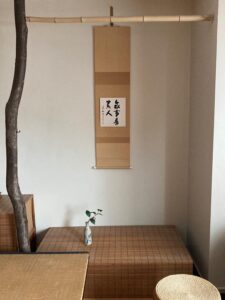
Kake-mono, 掛物, hang-thing, displaying a shiki-shi, 色紙, color-paper, with calligraphy, Bu-ji kore ki-nin, 無事是貴人, No-matter is noble-person, written by Matsu-naga Gō-zan, 松長剛山, Pine-ever Strength-mountain, abbot of Kō-tō–in, 高桐院, High-paulownia-temple, sub-temple of Dai-toku-ji, 大徳寺, Great-virtue-temple, Kyōto. Signed: Murasaki-no Gō-zan, 紫野剛山, Purple-field Strength-mountain, and red ink stamps for the temple and the abbot. Kōtōin is the family temple of the Hoso-kawa, 細川, Narrow-river, clan, founded by Taka-oki, 忠興, Loyal-revive, who is also named San-sai,三斎, Three-abstain. He was one of Rikyū’s most devoted followers, and was married to Gracia, the daughter of the traitorous Akechi Mitsuhide. Murasakino is an area in the northern part of Kyōto, and is the location of Daitokuji.
The aristocracy of Japan’s imperial court are recognized as ‘kinin’, 貴人, noble-person. In familiar Japanese, these Kanji are read ‘kijin.’
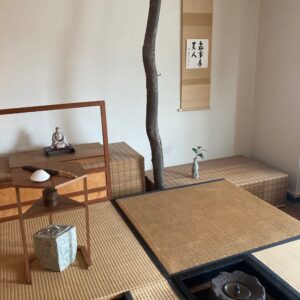
Ga-ran-dō, 伽蘭洞, Help-orchid-cave, prepared for a lunar Hina Matsuri, 雛祭, Doll Festival. Some utensils having the theme of the hishi, 菱, rhombus.
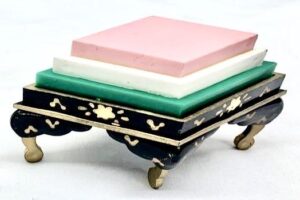
Model of hishi-mochi, 菱餅, rhombus-mochi, diamond-shape graduated pieces of pink, white, and green mochi displayed on a hishi-shape stand. Made for the doll display on Hina Matsuri, 雛祭り, Doll Festival, held on the 3rd day of the 3rd month. Although originally observed according to the lunar calendar, it is more popularly held on March 3.
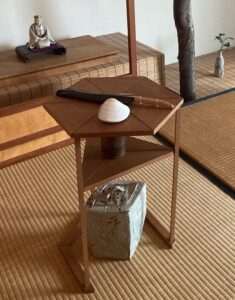
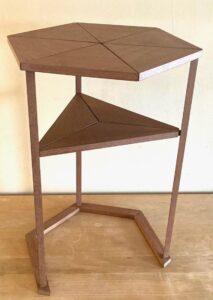
Tana, 棚, shelf, hexagonal, wooden stand for displaying cha-dō-gu, 茶道具, tea-way-tools, designed by Palmer and made by Thomas Hucker. The top shelf is composed of six triangles, the triangular middle shelf is composed of three triangles, the angular frame base is composed of four pieces, with three triangular section posts.
The main purpose of a tana is to display a tea container. The present tana has no baseboard, ji-ita, 地板, earth-board, as it is intended for use with a mizu-sashi, 水指, water-indicate, that is wet, and that is carried into and out of the tearoom in the presence of the guests. One of Rikyū’s tenets is that the teishu should carry water. This type of display stand is called a hakobi dana, 運棚, carry shelf. Although there are similar tana without a jiita, there are a few display stands with jiita which may have a wet mizusashi placed on the board. These tana have plain wood shelves. It is said that Rikyū’s ‘Yama zato dana’, 山里棚, Mountain-village shelf, a plain wood display stand with a triangular upper shelf, was inspired by a triangular shelf in the mizu-ya, 水屋, water-room, that was intended as a place for a Ten-moku cha-wan, 天目茶碗, Heaven-eye tea-bowl. A wet mizusashi can be displayed on the display stand’s baseboard, as the floor of the mizuya is often wet and towel-dried.
Mizusashi that are intentionally made wet that are displayed in the Tearoom, are those that are usually unglazed ceramic vessels. Typical unglazed ceramic mizusashi include such wares as Bi-zen yaki, 備前焼, Provide-fore fired, Shi-ga-raki, 信楽焼, Faith-pleasure fired, I-ga yaki, 伊賀焼, That-joy fired. Other wet vessels that are not ceramic include the wooden te-oke, 手桶, handle-bucket, wooden mage, 曲, bent, mizusashi, etc.
When using a mizusashi that is carried into and or carried out of the Tearoom in the presence of the guests, the futa-oki, 蓋置, lid-place, for the kama, 釜, kettle, should be ao-dake, 青竹, green-bamboo. This is also true when using a hakobi dana, 運棚, carry shelf, without a baseboard.
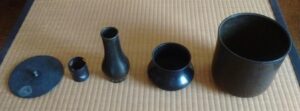
Kai-gu, 皆具, all-tools, patinated Kara-kane, 唐銅, Tang-copper, bronze utensils used in the preparation of Tea using a large display stand, dai-su, 台子, support-of, or a nagai-ita, 長板, long-board. From the right: mizu-sashi, 水指, water-indicate, ken-sui, 建水, build-water, shaku-tate, 杓立, futa-oki, 蓋置, lid-place, and futa, 蓋, lid of the mizusashi.
There is a standard in Chanoyu regarding the futaoki. The futaoki is part of the set of utensils, kai-gu, 皆具, all-tools, displayed on the ji-ita, 地板, earth-board of the dai-su, 台子, support-of, the futaoki is located inside ken-sui, 建水, build-water, bowl. When not using the daisu or naga-ita, 長板, long-board, the futaoki is carried into the Tearoom in the kensui, together with the hishaku, 柄杓, handle-ladle. At the conclusion of the hakobi Tea presentation, the futaoki is carried in hand together with the hishaku because the kensui is filled with water. A display futaoki cannot be carried together with the hishaku in the hand. The only futaoki that can be carried out in hand is the ao-dake, 青木, green-bamboo, or plain bamboo futaoki.
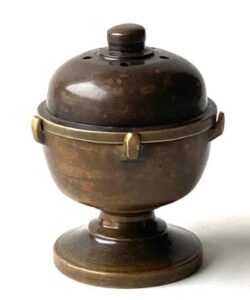
There is a futaoki that should never be carried in or out of the Tearoom, in the presence of the guest, which is the hoya kō-ro futaoki, 火舎香炉蓋置, fire-house incense-hearth lid-place. It is essential that it remains in the Tearoom. And, it is used only with the daisu and the nagaita. The hoya gōro has its origins in the utensils used in Buddhist altars.
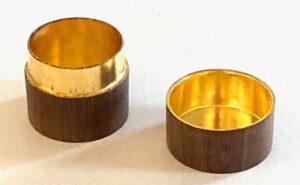
Cha-ki, 茶器, tea-container, cylindrical, naka-tsuki, 中付, middle-join, kuwa, 桑, mulberry, wood, interior lined with gold leaf; H. 1.8 sun kujira-jaku; Tan-tan-sai, 淡々斎, Light-light-abstain, XIV Iemoto, Urasenke. Ideally, the diameter should be the same as the height, 1.8 sun kujira-jaku. This tea container is used primarily to prepare koi-cha, 濃茶, thick-tea, in the presentation called Wa-kin Date, 和巾点, Harmony (Japan)-cloth Offer, which features a treasured ko-buku-sa, 古帛紗, old-cloth-gauze.
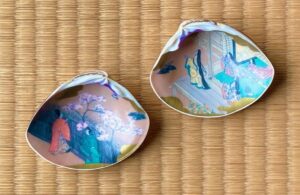
Hamaguri, 蛤, clam, suggests two words, hama, 浜, beach, and kuri, 栗, chestnut, and there is a semblance of form. The interior is decorated with a scene from Chapter Waka Murasaki, 若紫, Young Purple, of the Gen-ji Mono-gatari, 源氏物語, Origin-clan Thing-narrative. Only the two halves of a single clamshell can be fitted together.
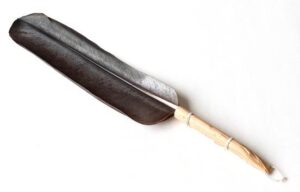
Ha-bōki, 羽箒, feather-brush, used to sweep the hearth edge or frame, etc. in the sumi de-mae, 炭点前, charcoal hand-fore, made of feathers from the hishikui, 鴻, bean goose, Anser fabalis, large bird, wild goose, as well as large, great, powerful, prosperous. The Kanji is also read ōtori, ōgari, etc.; L. 10.8 sun kane-jaku. The name of the goose is also written with the Kanji, hishi-kui, 菱喰, caltrop-eat, as the goose eats the caltrop fruits.
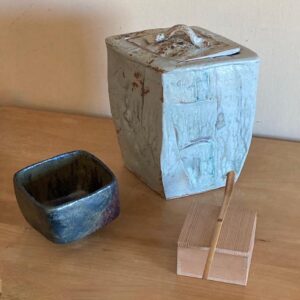
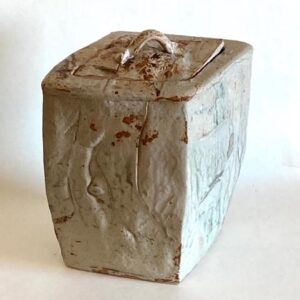
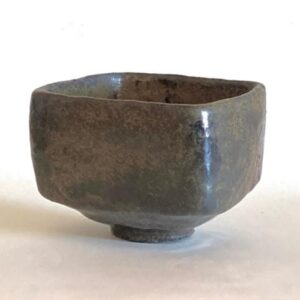
Cha-wan, 茶碗, tea-bowl, yo-hō, 四方皿, four-direction, square, ceramic bowl with mottled black glaze, by Sa-sa-ki Shō-raku, 佐々木昭楽, Assist-assist-tree Bright-pleasure, copy of a square chawan made by Chō-ji-rō, 長次郎, Lengthy-next-son, [d. 1592]. The bowl was commissioned by Sen Rikyū. Rikyū, who wanted a square chawan which was inspired by his square kama, 釜, kettle. Rikyū named the teabowl, ‘Muki–guri’, ムキ栗, ‘peel’-chestnut. Several Raku chawan were modeled after kama, mirroring the kama when the chawan was inverted; the ring foot of the bowl was similar to the mouth of the kettle.
The name of the bowl, ‘muki-guri,’ was written with the Katakana for muki, ムキ, which questions whether it should be the Kanji for muki, 剥, meaning peel. There may be wordplay on ku-ri, 庫裏, storehouse of [consciousness]-inner, Buddhist priest’s residence, as well as wordplay on muki, 向き, meaning facing. Another of Rikyū’s chawan, called ‘Tō-yō-bō’, 東陽坊, East-yang-quarter, refers to a priest’s residence Teahouse at Ken-nin-ji, 建仁寺, Build-benevolence-temple, the first Zen temple in Kyōto. Tōyōbō, Rikyū’s friend for whom he named the bowl, had the same name as his residence, Tōyōbō. Names in Japan are often taken by the location of the resident: the celebrated Zen priest, Hyakujō, is known by the name of the mountain in China where his temple was located.

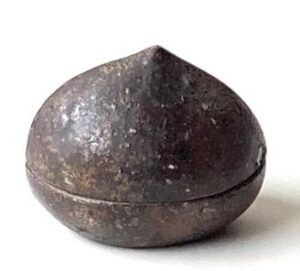

The Kanji, 栗, chestnut, is composed of the Kanji for ‘nishi, 西, west, and ki, 木, tree, seemingly to mean ‘west-tree’. The form of the chestnut resembles the hō-ju, 宝珠, treasure-jewel, which is symbolic of combined water and fire, In and Yō, 陰陽, Yin and Yang, negative and positive, and emblematic of the paradise of Amida that is located in the West.
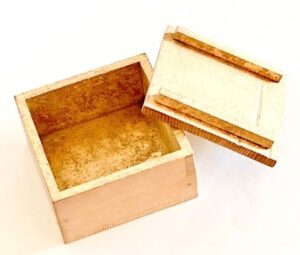

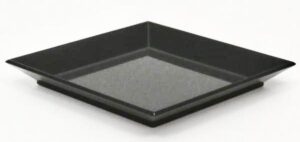
For further study, see also: Hishi Mochi and Hina Matsuri, Hina Matsuri, and Tea in March Part 2

